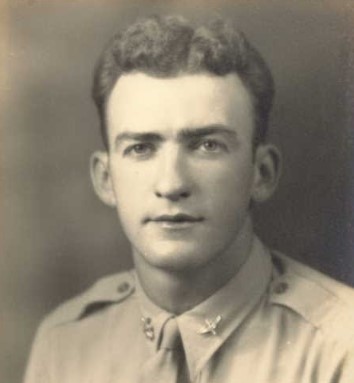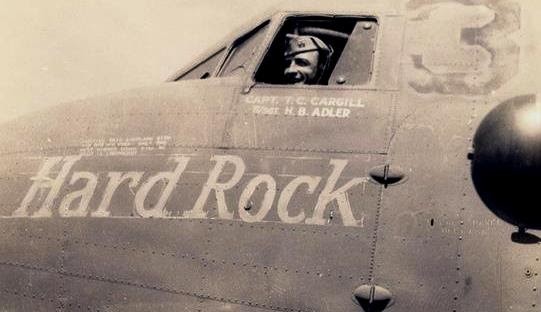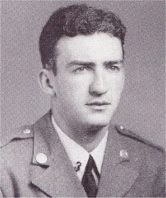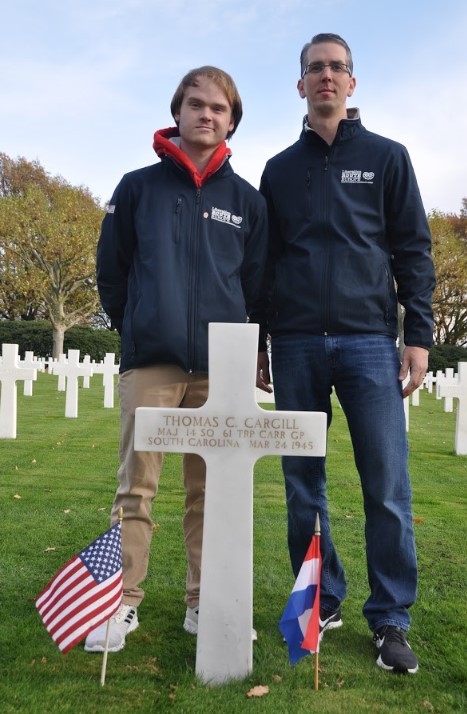Major Thomas Clayton Cargill

- Unit: 14th Squadron, 61st Troop Carrier Group
- Service Number: O-789680
- Date of Birth: June 6, 1919
- Entered the Military: October 2, 1941
- Date of Death: March 24, 1945
- Hometown: Montgomery, Alabama
- Place of Death: near Wesel, Germany
- Award(s): Distinguished Flying Cross, Air Medal with two Oak Leaf Clusters, Purple Heart
- Cemetery: Plot P, Row 3, Grave 3. Netherlands American Cemetery, Margraten, Netherlands
Mentored by Mr. Scott Auspelmyer
Blythewood High School
2019-2020
Early Life
Thomas Clayton Cargill was born in Montgomery, Alabama, on June 6, 1919. He was the only child of Romeo Ernest Cargill and Mary Louise Cargill. His father worked as a pressman for the Birmingham Age-Herald. While both Romeo and Mary Louise Cargill had strong family ties to Alabama, the Great Depression of the 1930s forced a move to Columbia, South Carolina, where his father found a job with a local newspaper.
In 1938, after graduating from Columbia High School as a track and football star, Cargill began studying textile engineering at Clemson University in South Carolina. While there, he was a three-sport athlete, competing in college football, track, and boxing. During his freshman year, he set a state record in the 440-yard dash, which he still held when he dropped out in the fall of 1941. It is unclear why Cargill dropped out of Clemson University.
He joined the U.S. Army Air Corps just two months before the United States officially entered World War II.
Homefront
In 1940, the U.S. Army reestablished Camp Jackson, South Carolina as the largest U.S. Army base to prepare for the possible entrance of the United States into World War II. Later the camp turned into a permanent base. The base brought nearly 40,000 people to the city, greatly bolstering the economy, as thousands of recruits trained here during the war. Columbia became a military town, and many historians considered this revitalization of Camp Jackson as a key economic change in Columbia’s post-Depression society.
Secondary operations for the U.S. Army took place at Columbia Army Air Base, Congaree Army Air Field, and Owens Field. Other organizations, like the United Service Organization, tried to address the boredom of these soldiers who were awaiting their assignments with leisure and entertainment activities.
For South Carolina, the war meant a boost in the agricultural sector. South Carolina’s agricultural economy had been greatly affected by the Great Depression. In fact, the United States farming and agricultural industry suffered the most, entering a severe economic slump as early as 1927. However, war time production changed the economic climate of South Carolina. From 1939 to 1943, high demands for cotton and produce rose across the country, and South Carolina’s farmers saw their earnings doubled. However, the demand became so high that they could no longer keep up, so between 8,000 and 11,000 German prisoners of war worked as contract laborers to help farmers reach the high levels of production that were needed by the military.
The influx of people coming to South Carolina during the early 1940s also brought about social change. Many people had different views on social customs, chipping away at Jim Crow segregation in the American South by pushing for change. This demand led to more relaxed social environments at many military bases. In the late 1940s, Camp Jackson (later Fort Jackson) became one of the first military bases to desegregate. This change has been attributed to the diverse population who came for military training here, including activists who pushed for Fort Jackson to abandon segregation.
Military Experience
Before the United States entered World War II on December 7, 1941, Thomas Cargill traveled to Camp Jackson, where he enlisted in the U.S. Army Air Corps on October 2, 1941. His fellow soldiers and superiors remembered Cargill as a “natural pilot.” After only eight hours of dual instruction, Cargill successfully completed his first solo ride in Arcadia, Georgia, and he quickly became one of the top pilots in the U.S. Army Air Corps. After graduating from flight school at Turner Field in Atlanta,
Georgia, Cargill earned his silver wings and second lieutenant gold bars on May 20, 1942.
On May 27, 1942, Cargill joined the 61st Transport Group stationed at Pope Field, North Carolina. He then moved to the 15th Troop Carrier Squadron and flew the McDonald-Douglas C-47. Cargill operated as the Liaison Officer, becoming third in command of his squadron. By late 1942, he had been promoted to first lieutenant, and on April 17, 1943, Cargill earned a promotion to captain.
The 15th Troop Carrier Squadron transferred to the 12th Air Force in May 1943, when they were sent to Lourmel, Algeria. Cargill flew plane #42-23300, which he nicknamed Hard Rock. After flying the South Atlantic Air Ferry Route for training purposes, the 15th Troop Carrier Squadron moved to Kairouan, Tunisia. Here, Cargill worked as an operations officer, now second in command of his squadron.
On July 9, 1943, Cargill participated in the Allied Invasion of Sicily, codenamed Operation Husky. As part of Operation Husky, Cargill dropped paratroopers into Sicily. This first mission went nearly flawlessly, and all crew members and planes survived.
However, on July 11, 1943, Cargill and the 15th Troop Carrier Squadron ran into trouble. Miscommunication between the U.S. Army and U.S. Navy led to friendly fire. U.S. Navy boats fired at Cargill’s squadron, causing two C-47s to go down and seriously injuring one pilot. Cargill’s plane survived unscathed, and he made it back safely to the base. Operation Husky was a success for the Allied Powers, as they forced the Axis Powers’ land, naval, and air forces from Sicily. Operation Husky is also remembered as a key moment for the Allied offensive as it pushed Benito Mussolini out of power in Italy, a major victory for the Allied Powers.
In order to prepare for the Cross Channel invasion of the Nazi-occupied areas of Europe, the 15th Carrier Squadron then relocated to Station 483 in Barkston Heath, England. On his twenty-fifth birthday, June 6, 1944, Cargill ferried paratroopers from the 82nd Airborne Division, 507th Parachute Infantry Regiment, 2nd Battalion, Headquarters Company, into France. He had a reputation for caring deeply about the members of his squadron, and many witnessed this firsthand when First Lieutenant Claude Breeden was shot down over the English Channel. After Breeden and his crew swam to shore and radioed Station 483, Major Cargill turned his C-47 around and flew back to Exeter to pick them up. All of them returned safely.
Operation Varsity was designed to help the airborne assault troops secure parts of the Rhine River in March 1945. Cargill flew as a pilot of the Serial B-2, carrying Canadian paratroopers into Germany across the Rhine River. On the way back to his base in Abbeville, France, Cargill’s plane flew into tracer fire. Other pilots who witnessed the incident described smoke coming from the left wing and then from the cockpit. The plane lost altitude quickly, completely losing its left wing as it hit a house before exploding upon impact. There were rumors of a parachute coming out of the plane while it was losing altitude, but no one aboard the plane survived the crash.
Following his death, Cargill was awarded the Distinguished Flying Cross, the Air Medal, and the Purple Heart. He was remembered back home by family and friends in both Columbia and Montgomery. Many local newspapers published articles about him and his contributions to the war.
In 1949, Cargill’s parents received a letter from the Quartermaster General detailing the location of their son’s remains. They were told that he would be “side by side with comrades who also gave their lives for their country.” The letter also stated that the cemetery in Margraten would not be accepting visitors until all interments were completed, which prompted Mr. and Mrs. Cargill to pen a letter of their own.
The two wrote to Senator Olin Johnston asking if there was “any movement or talk of a bill” that would allow the parents of soldiers killed in action to travel and visit their child’s grave at no expense. While such a bill was never brought to fruition, Senator Johnston was able to get Cargill’s family in touch with travel agencies that could bring them to visit their son’s grave.


Eulogy
Thomas Cargill dropped out of Clemson University and traveled to Camp Jackson, where he enlisted on October 2, 1941 in the peacetime Air Corps. With only eight hours of dual instruction, Cargill successfully completed his first solo ride in Arcadia, Georgia, and after graduating from flying school at Turner Field, he earned his Pilot’s silver wings and Second Lieutenant gold bars on May 20, 1942.
On July 9, 1943, Officer Cargill participated in the Allied Invasion of Sicily, codenamed Operation Husky. As Cargill’s first combat mission, he was tasked with dropping paratroopers into Sicily during Operation Husky. This mission went nearly flawlessly, and all crew members and planes survived. Finally, on April 1, 1944, Thomas Clayon Cargill was promoted to Major at only 24 years of age.
An Allied airborne operation, known as Operation Varsity, designed to help the assault troops secure parts of the Rhine River in March of 1945 marked Major Cargill’s last mission. Major Cargill flew as a pilot of the Serial B-2, carrying Canadian paratroopers into Germany across the Rhine River. On the way back to his base in Abbeville, France, Major Cargill’s plane flew into tracer fire. Other pilots who witnessed the incident claim that smoke started to come out of the left wing, and then from the cockpit. The plane lost altitude quickly, completely losing its left wing as it hit a house before exploding upon impact with the ground. There were rumors of a parachute coming out of the plane while it was losing altitude, but no one aboard the plane survived the crash.
Major Thomas Clayton Cargill was posthumously awarded the Distinguished Flying Cross, the Air Medal, and Purple Heart. He was buried at the Netherlands American Cemetery in Margraten, Netherlands. Cargill left behind his father, Romeo, and his mother, Mary.

Reflection
The Operation Liberty program was the most amazing experience that I have ever had. Being able to learn about history in a way that made it real has forever changed how I view these events. Before doing the research for this trip, World War II just felt like something that happened in the past that had no significance to me. However, learning about someone from my hometown made it so much more realistic and showed me that it was everyday people who were putting their lives on pause in order to go overseas and free people that they didn’t even know.
Being able to go to the American cemetery in Margraten was extremely humbling. Seeing how well the Dutch people took care of, and continue to take care of, the U.S. servicemembers who died was heartwarming. They have spent countless hours visiting the graves that they have adopted in order to care for the burial spot of a soldier that they never knew, but to whom they are thankful for freeing them from the Nazis. The way the Dutch people have passed this gratitude down through the generations amazed me as well, as the older this conflict becomes in United States history, the less importance it has to those of us who are learning about it.
This is something that I would like to see fixed, and I hope that there is a way for the gratitude that I now hold for the American soldiers who died in World War II to be shared with others who do not have the opportunity to go to the Netherlands and see just how much it means to the people over there.
This drive to do more to commemorate the Silent Heroes who died in World War II inspired me to focus on them for my Senior Project. At Blythewood High, all of the members of the Honors Forum program must complete a senior project of their choosing, and I decided to run a social media campaign to raise awareness for soldiers from Columbia, South Carolina who died in World War II. In doing this, I hope to inspire other people to look into the lives of these soldiers, and others, and to understand that these people were everyday citizens who went above and beyond to protect people they did not know.
Bibliography
Primary Sources
Alabama. Jefferson County. 1920 U.S. Federal Census. Digital Images. ancestry.com
“Maj. Thomas C. Cargill’s Death in Action Reported to Family,” The Montgomery Advertiser, November 4, 1945. Accessed October 14, 2019. ancestry.com.
South Carolina. Richland County. 1940 U.S. Federal Census. Digital Images. ancestry.com.
Thomas Cargill, Official Military Personnel File, Department of the Air Force, Record of the U.S. Air Force Commands, Activities, and Organizations, RG 342, National Archives and Records Administration – St. Louis.
Thomas C. Cargill. U.S. World War II Army Enlistment Records, 1938-1946. ancestry.com.
Thomas C. Cargill, Individual Deceased Personnel File, Department of the Army.
Secondary Sources
“Cargill, Thomas C.,” Fields of Honor. Accessed October 14, 2019. www.fieldsofhonor-database.com/index.php/en/american-war-cemetery-margraten-c/66942-cargill-thomas-c.
Cronenberg, Allen T. “World War II and Alabama.” Encyclopedia of Alabama, December 12, 2014. www.encyclopediaofalabama.org/article/h-1348.
Hamer, Fritz. “World War II.” South Carolina Encyclopedia. University of South Carolina, Institute for Southern Studies, September 13, 2016. www.scencyclopedia.org/sce/entries/world-war-ii/.
Lewis, Randall W. “Thomas Clayton Cargill.” Clemson Corps, March 17, 2011. soh.alumni.clemson.edu/scroll/308/.
“Maj Thomas Clayton Cargill,” Find a Grave. Accessed October 9, 2019. www.findagrave.com/memorial/64758412.
“Thomas C. Cargill.” Thomas C. Cargill American Battle Monuments Commission. Accessed January 27, 2020. www.abmc.gov/node/531236.
“Thomas Clayton Cargill,” Honorstates.org. Accessed October 14, 2019. www.honorstates.org/index.php?id=79060.

